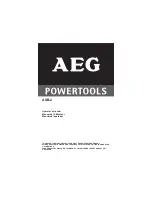
5
OPERATION
WARNING
To reduce the risk of injury, always
wear proper eye protection marked
to comply with ANSI Z87.1.
When working in dusty situations, wear appro-
priate respiratory protection or use an OSHA
compliant dust extraction solution.
Bit binding
If the bit binds, the drill will suddenly react in the
opposite direction of the rotation of the bit. Reduce
the chances of a sudden reaction by following the
instructions listed below. Prepare for a sudden reac
-
tion by holding or bracing securely.
To reduce the chance of bit binding:
• Use sharp bits. Sharp bits are less likely to bind
when drilling.
• Use the proper bit for the job. There are many types
of bits designed for specific purposes.
• Keep selfeed bits aligned with the work surface so
bits go in straight (see "Drilling").
• Avoid drilling warped, wet, knotty, and/or pitchy
material if possible.
• Avoid drilling in material that you suspect contains
hidden nails or other things that may cause the bit
to bind.
The direction of reaction is always opposite of the
direction of bit rotation. Reaction is even more likely
to occur when enlarging already existing holes and
at the point when the bit breaks through the other
side of the material.
If the bit does bind:
1. Release the trigger immediately.
2. Reverse the motor.
3. Remove the bit from the work and start again.
4. Do not pull the trigger on and off to attempt to start
a stalled bit. This will damage the drill.
Bracing for forward rotation
When drilling in forward, the bit will rotate in a clock-
wise direction. If the bit binds in the hole, the bit will
come to a sudden stop and drill will suddenly react
in a counterclockwise direction.
The following figure shows an example of properly
bracing the tool for forward rotation.
A. Forward (clockwise) rotation
B. Reaction
C. Brace drill with motor housing here
If the bit binds, the motor housing braced against the
stud will hold the drill in position.
A
B
D
A
B
C
A
B
D
A
B
C
Bracing for reverse rotation
When drilling in reverse, the bit will rotate in a coun-
terclockwise direction. If the bit binds in the hole,
the bit will come to a sudden stop and the drill will
suddenly react in a clockwise direction.
The following figure shows an example of properly
bracing the tool for reverse rotation.
A. Reverse (counterclockwise) rotation
B. Reaction
C. Brace drill with motor housing here
If the bit binds, the motor housing braced against the
stud will hold the drill in position.
B
C
A
B
D
A
B
C
A
B
D
A
Shifting Speeds
Use the shift knob to select High (H) or Low (L) speed.
High speed (1 550 RPM) is the low torque setting.
Low speed (500 RPM) is the high torque setting.
See the "Specifications" section for bit capacity limits
under high and low speeds.
Always turn off the switch and shift speeds while the
tool is stopped. Never shift the drill while it is moving
or when it is under load.






































